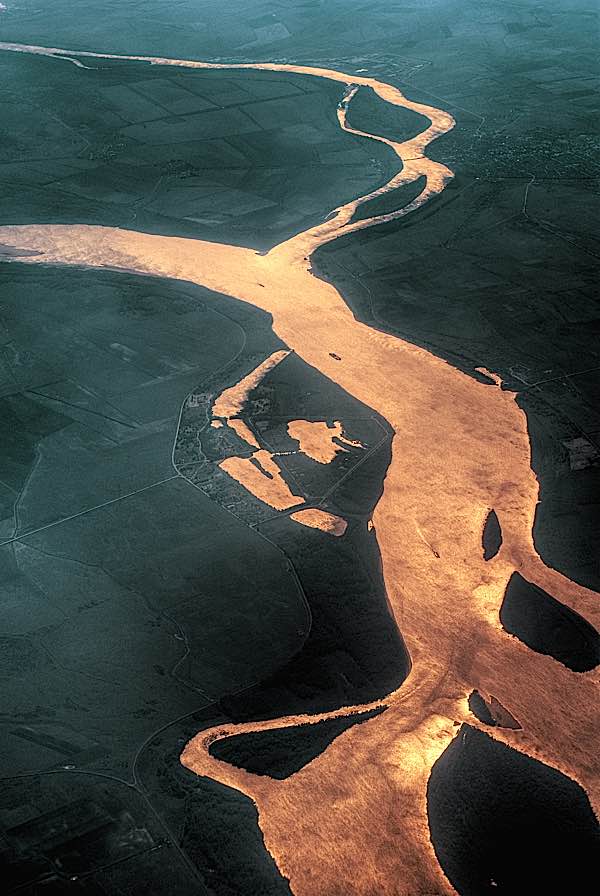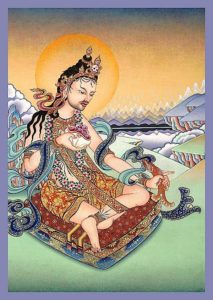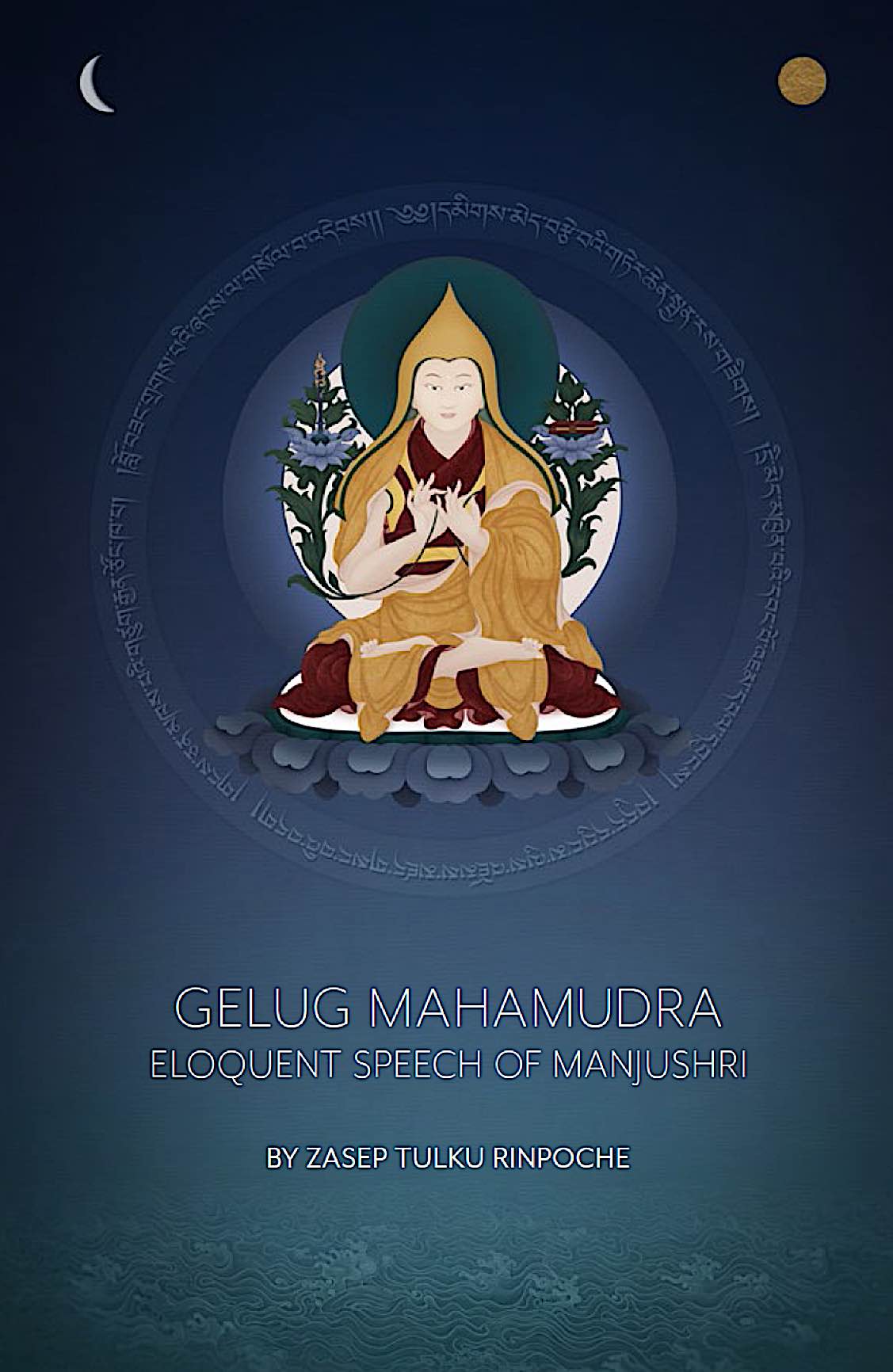Pith Instructions on Mahamudra from Mahasiddha Tilopa: The Ganges Mahamudra Upadesha
 The great Mahasidda Tilopa said to Naropa: “Mahamudra cannot be taught.” The most profound teachings on Mahamudra — designed to allow the student to develop their own awareness — famously came from the great Mahasiddhas Tilopa and Saraha, in Dohas (songs.) Even though it cannot be “taught,” pith instructions help students “coach themselves.”
The great Mahasidda Tilopa said to Naropa: “Mahamudra cannot be taught.” The most profound teachings on Mahamudra — designed to allow the student to develop their own awareness — famously came from the great Mahasiddhas Tilopa and Saraha, in Dohas (songs.) Even though it cannot be “taught,” pith instructions help students “coach themselves.”
Recently, in answering a student at a teaching on meditation, Venerable Zasep Rinpoche referenced both Tilopa and Saraha [full video here>>], and gave an especially vivid, and helpful, description of Tilopa’s “Ganges Mahamudra” song:
“When you meditate … You see your mind is rushing down, like a river coming down from the mountains of the Himalayas. Rushing down. Strong mind… Then, at some point you see your mind, the same river, like the Ganges river, but now it is flowing down into the Indian plains. Not rushing, just moving. Strongly, and smoothly moving … Then, you see your mind is now merging with the great ocean… all gone into the ocean, becoming one taste. Likewise, when you experience Mahamudra, you experience Emptiness. Clear light and bliss. There is no Samsaric mind.”

Rinpoche was explaining how we can use Saraha’s Doha’s, and the songs from Tilopa and the great Marpa and Milarepa to self-coach ourselves on advanced meditation — “be your own Guru,” he said. “You have to follow the footsteps of Mahamudra. You have to coach yourself. That’s why we sing those, what we call ‘Doha.’.. Poems of Mahamudra.” Rinpoche advised studying them and even reciting them. (Most are available online.) With this in mind, we’re reproducing the most famous of these, by the great Mahasiddha Tilopa, “The Pith Instructions on Mahamudra” — also known as the Ganges Mahamudra song.

Venerable Khenchen Thrangu Rinpoche described Tilopa’s Mahamudra Upadesha as “Tilopa’s most significant teaching.” In a commentary in Vancouver, Venerable Thrangu Rinpoche pointed out that Naropa — who was the student of Tilopa — had already undergone “austerities” and “met a number of extraodrdinary, great teachers and mahasiddhas.” This implies that these instructions are advanced, requiring years of foundation practices, before they can be understood. Naropa, after all, by this time, was already a most advanced scholar in his own right.
If Tilopa began by saying “Mahamudra cannot be taught” why are these called his instructions to his student, Naropa? Venerable Thrangu Rinpoche explained,
“Mahamudra cannot be taught because it is absolute truth and therefore cannot be expressed in words or even concepts. As was said by Shantideva, ‘Absolute truth is not an object of intellect because the intellect itself is a relative truth.’ The intellect is an aspect of ignorance and therefore intellect is always ignorant.”

Rinpoche went on to explain: “because Mahamudra is emptiness, because it is the absence of substantiality of the mind, it therefore cannot be shown.”
The key instruction, the pith, is Tilopa’s instruction: “Rest, relaxed in nature,” which Rinpoche explained meant “the nature of your mind — without alteration. “Normally when we think about our minds we think of them as miserable, even pitiful, and quite afflicted. And indeed they may seem to us from time to time to be like that. But in fact, that is not the true condition of your mind. As was said by Saraha, “Homage to the mind that is like a wish-fulfilling jewel.
“A wishfulfilling jewel is something that in legends is supposed to be able to grant any wish. And the reason the mind is compared to this legendary wish-granting or wish-fulfilling jewel is that, if you attend to your mind, if you look at your mind, then by coming to know it you will realize the nature of everything. And in order to do this you do not need to attempt to alter what your mind is. Not altering the mind means that you simply rest in your mind as it is. If your mind is something, then rest in that something; and if your mind is nothing, then rest in that nothing. Do not feel that you have to turn it into nothing if it seems to be something, or turn it into something if it seems to be nothing. Of course, the mind is not something. It has no substantial characteristics. And it is not nothing, because it is lucid cognition. It is simply your mind and you just rest in it as it is without attempting to make it into anything other than what it is. And if you can do that, then you will realize the view of mahamudra.”
Tilopa’s concise Upadesha presented instructions in “seven topics.” According to Khenchen Rinpoche these are:
- the view of Mahamudra
- the conduct of Mahamudra
- the meditation of Mahamudra
- the samaya of Mahamudra
- the benefit of Mahamudra
- the defect of not practicing Mahamudra
- how to actually practice Mahamudra
Teachers of advanced Mahamudra and Dzogchen often refer to the great Tilopa Ganges metaphor.
[Full “Pith Instructions on Mahamudra from Tilopa below.]
Pith Instructions on Mahamudra
(translated by Ken McLeod)
I bow to Vajra Dakini.
1

Mahamudra cannot be taught, Naropa,
But your devotion to your teacher and the hardships you’ve met
Have made you patient in suffering and also wise:
Take this to heart, my worthy student.
2
For instance, consider space: what depends on what?
Likewise, mahamudra: it doesn’t depend on anything.
Don’t control. Let go and rest naturally.
Let what binds you let go and freedom is not in doubt.
3
When you look into space, seeing stops.
Likewise, when mind looks at mind,
The flow of thinking stops and you come to the deepest awakening.
4
Mists rise from the earth and vanish into space.
They go nowhere, nor do they stay.
Likewise, though thoughts arise,
Whenever you see your mind, the clouds of thinking clear.
5
Space is beyond color or shape.
It doesn’t take on color, black or white: it doesn’t change.
Likewise, your mind, in essence, is beyond color or shape.
It does not change because you do good or evil.
6
The darkness of a thousand eons cannot dim
The brilliant radiance that is the essence of the sun.
Likewise, eons of samsara cannot dim
The sheer clarity that is the essence of your mind.
7
Although you say space is empty,
You can’t say that space is “like this”.
Likewise, although mind is said to be sheer clarity,
There is nothing there: you can’t say “it’s like this”.
8
Thus, the nature of mind is inherently like space:
It includes everything you experience.
9
Stop all physical activity: sit naturally at ease.
Do not talk or speak: let sound be empty, like an echo.
Do not think about anything: look at experience beyond thought.
10
Your body has no core, hollow like bamboo.
Your mind goes beyond thought, open like space.
Let go of control and rest right there.
11
Mind without projection is mahamudra.
Train and develop this and you will come to the deepest awakening.
12
You don’t see mahamudra’s sheer clarity
By means of classical texts or philosophical systems,
Whether of the mantras, paramitas,
Vinaya, sutras or other collections.
13
Ambition clouds sheer clarity and you don’t see it.
Thinking about precepts undermines the point of commitment.
Do not think about anything; let all ambition drop.
Let what arises settle by itself, like patterns in water.
No place, no focus, no missing the point —
Do not break this commitment: it is the light in the dark.
14
When you are free from ambition and don’t hold any position,
You will see all that the scriptures teach.
When you open to this, you are free from samsara’s prison.
When you settle in this, all evil and distortion burn up.
This is called “The Light of the Teaching”.
15
The foolish are not interested in this.
The currents of samsara constantly carry them away.
Oh, how pitiable, the foolish — their struggles never end.
Don’t accept these struggles, long for freedom, and rely on a skilled teacher.
When his (her) energy enters your heart, your mind is freed.
16
What joy!
Samsaric ways are senseless: they are the seeds of suffering.
Conventional ways are pointless. Focus on what is sound and true.
Majestic outlook is beyond all fixation.
Majestic practice is no distraction.
Majestic behavior is no action or effort.
The fruition is there when you are free from hope and fear.
17
Beyond any frame of reference mind is naturally clear.
Where there is no path you begin the path of awakening.
Where there is nothing to work on you come to the deepest awakening.
18
Alas! Look carefully at this experience of the world.
Nothing lasts. It’s like a dream, like magic.
The dream, the magic, makes no sense.
Experience this grief and forget the affairs of the world.
19
Cut all ties of involvement with country or kin,
Practice alone in forest or mountain retreats.
Rest, not practicing anything.
When you come to nothing to come to, you come to mahamudra.
20
A tree spreads its branches and leaves.
Cut the root and ten thousand branches wither.
Likewise, cut the root of mind and the leaves of samsara wither.
21
Though darkness gathers for a thousand eons.
A single light dispels it all.
Likewise, one moment of sheer clarity
Dispels the ignorance, evil and confusion of a thousand eons.
22
What joy!
With the ways of the intellect you won’t see beyond intellect.
With the ways of action you won’t know non-action.
If you want to know what is beyond intellect and action,
Cut your mind at its root and rest in naked awareness.
23
Let the cloudy waters of thinking settle and clear.
Let appearances come and go on their own.
With nothing to change, the world you experience becomes mahamudra.
Because the basis of experience has no beginning, patterns and distortions fall away.
Rest in no beginning, with no self-interest or expectation.
Let what appears appear on its own and let conceptual ways subside.
24
The most majestic of outlooks is free of all reference.
The most majestic of practices is vast and deep without limit.
The most majestic of behaviors is open-minded and impartial.
The most majestic of fruitions is natural being, free of concern.
25
At first, practice is a river rushing through a gorge.
In the middle, it’s the river Ganges, smooth and flowing.
In the end, it’s where all rivers meet, mother and child.
26
When your mind is less acute and does not truly rest,
Work the essentials of energy and bring out the vitality of awareness.
Using gazes and techniques to take hold of mind
Train awareness until it does truly rest.
27
When you practice with a sexual partner, empty bliss awareness arises.
The balancing of method and wisdom transforms energy.
Let it descend gently, collect it, draw it back up,
Return it to its place, and let it saturate your body.
When you are free from longing and desire, empty bliss awareness arises.
28
You will have a long life, you will not gray, and you will shine like the moon.
You will radiate health and well-being and be as strong as a lion.
You will quickly attain the ordinary abilities and open to the supreme one.
May these pith instructions, the essentials of mahamudra,
Abide in the hearts of all worthy beings.
Colophon: Tilopa’s Mahamudra Instruction to Naropa in twenty Eight Verses was transmitted by the Great Guru and Mahasiddha Tilopa to the Kashmiri Pandit, Sage and Siddha, Naropa, near the banks of the River Ganga upon the completion of his Twelve Austerities. Naropa transmitted the teaching in Sanskrit in the form of twenty eight verses to the great Tibetan translator Mar pa Chos kyi blos gros, who made a free translation of it at his village of Pulahari on the Tibet – Bhutan border.
This text is contained in the collection of Mahamudra instruction called the Do ha mdzod brgyad ces bya ba Phyag rgya chen po’i man ngag gsal bar ston pa’i gzhung, which is printed at the Gyalwa Karmapa’s monastery at Rumtek, Sikkim. The Tibetan title is Phyag rgya chen po’i man ngag, or Phyag rgya chen po rdo rje’i tsig rkang nyi shu rtsa brgyad pa.
This translation into English has been done by Kunzang Tenzin in 1977, after transmission of the oral teaching by Khamtrul Rinpoche in Tashi Jong, Kangra Valley, India.
As an Amazon Associate, Buddha Weekly may earn from qualifying purchases.
Teachings on Mahamudra

Zasep Tulku Rinpoche teaches on Gelug Mahamudra as a livestream YouTube on Tuesdays at 6:30pm Eastern Time (3:30pm PT). Go to the Gaden for the West Youtube Channel five minutes before the stream time, each Tuesday night. Each session includes teachings on Gelug Mahamudra and a meditation session. Go to YouTube>>
More articles by this author
Sorry, we couldn't find any posts. Please try a different search.
Search
Latest Features
Please support the "Spread the Dharma" mission as one of our heroic Dharma Supporting Members, or with a one-time donation.
Please Help Support the “Spread the Dharma” Mission!

Be a part of the noble mission as a supporting member or a patron, or a volunteer contributor of content.
The power of Dharma to help sentient beings, in part, lies in ensuring access to Buddha’s precious Dharma — the mission of Buddha Weekly. We can’t do it without you!
A non-profit association since 2007, Buddha Weekly published many feature articles, videos, and, podcasts. Please consider supporting the mission to preserve and “Spread the Dharma." Your support as either a patron or a supporting member helps defray the high costs of producing quality Dharma content. Thank you! Learn more here, or become one of our super karma heroes on Patreon.
Lee Kane
Author | Buddha Weekly
Lee Kane is the editor of Buddha Weekly, since 2007. His main focuses as a writer are mindfulness techniques, meditation, Dharma and Sutra commentaries, Buddhist practices, international perspectives and traditions, Vajrayana, Mahayana, Zen. He also covers various events.
Lee also contributes as a writer to various other online magazines and blogs.












